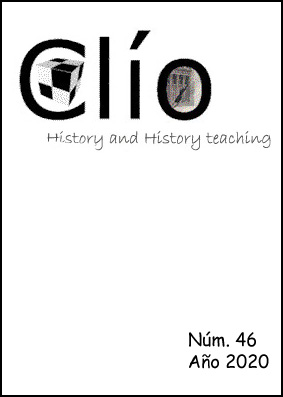Democracy, participation and European citizenship: mappinginstructional resources for teaching European coexistence and integration
DOI:
https://doi.org/10.26754/ojs_clio/clio.2020465256Keywords:
European citizenship, spatial citizenship, participation, democracyAbstract
Teaching confrontations (political, ethnic, racial, religious, etc.) carried out throughout the 20th century, and especially during the Second World War, is still a controversial issue in Social Sciences Education. Following the curriculum for the fourth year of secondary education, for the subject of Geography and History, this paper selects a series of useful cartographic instructional materials for the teaching-learning processes of the relationship between the past, the present and the projection into the future through these two disciplines. In addition to the learning standard referring to the Holocaust, this didactic proposal –based on the European Youthmetre and European Values Study projects- seeks to fulfill the understanding of the causes why Europe at war during the 20th century has been able to reach a union economic and political in the XXI century.
Downloads
References
Caballero, A., Cárdenas, J. F. y Valle, J. M. (2016). La educación para la ciudadanía en la Unión Europea: Perspectivas supranacional y comparada. Journal of supranational policies of education, 5, 173-197.
Comisión Europea / EACEA / Eurydice. (2017). La educación para la ciudadanía en el contexto escolar europeo 2017. Informe de Eurydice. Oficina de Publicaciones de la Unión Europea.
De Miguel. R. (2019). Europe in a global context: EUROGEO and The role of geography and european geographers. European Journal of Geography, 10(4), 160-176.
De Miguel, R. (2012). Análisis comparativo del curri?culum de Geografía en educación secundaria: revisión y propuestas didácticas. En R. de Miguel, M. L de Lázaro y M. J. Marrón (Eds.), La educación geográfica digital (pp. 13-36). Grupo de Didáctica de la Geografía (A.G.E.) y Universidad de Zaragoza.
Donert, K., De Miguel, R. y Luppi, A. (2019). YouthMetre: Open Data to Empower Young People to Engage in Democracy and Policymaking. En R. de Miguel, K. Donert y K. Koutsopoulos (Eds.), Geospatial technologies in Geography Education (pp. 87-101). Springer.
Gryl, I. y Jekel, T. (2012). Re-centering geoinformation in secondary education: Toward a spatial citizenship approach. Cartographica, 47(1), 18-28.
Gryl, I., Jekel, T. y Donert, K. (2010). GI and spatialcitizenship. En T. Jekel, K. Donert, A. Koller y R. Vogler (Eds.), Learning with GI V (pp. 2-10). Wichmann.
Jara, M. A. y Santisteban, A. (Coord.) (2018). Contribuciones de Joan Pagès al desarrollo de la dida?ctica de las ciencias sociales, la historia y la geografía en Iberoamérica. Universidad Nacional del Comahue.
Lee, W.O., Grossman, D.L., Kennedy, K.J. y Fairbrother, G.P. (Eds.) (2004). Citizenship Education in Asia and the Pacific. Springer.
Massip, M. y Santisteban, A. (2020). La educación para la ciudadanía democrática en Europa. Rev. Espaço do Currículo, 13(2), 142-152.
Pagés, J. y García, C. R. (2020). Qué piensa y qué escribe Ernesto Gómez. Su aportación a la Educación para la Ciudadanía Democrática. REIDICS, 7, 7-29.
Prats. J. (Dir.) (2001). Los jóvenes ante el reto europeo. Conocimientos y expectativas del alumnado de educación secundaria. Fundación La Caixa.
Downloads
Published
How to Cite
Issue
Section
License
Copyright (c) 2020 Rafael de Miguel González, María Sebastián López

This work is licensed under a Creative Commons Attribution-NonCommercial-ShareAlike 4.0 International License.
This work is licensed under a Creative Commons Attribution-NonCommercial-ShareAlike 4.0 International License.
Copyright remains the property of authors. Permission to reprint must be obtained from the authors and the contents of JoS cannot be copied for commercial purposes. JoS does, however, reserve the right to future reproduction of articles in hard copy, portable document format (.pdf), or HTML editions of JoS.






